
We’re all doing our part to be more eco-friendly, but let’s not beat around the bush: At the end of the day, even saving the environment needs to have an ROI. The primary function of a business is to generate revenue, after all; if your company doesn’t have revenue, your Green initiatives are kind of a moot point.
Corporate sustainability is not a new idea. While the term “greenwashing” didn’t come into use until the ’80s, and “business sustainability” until John Elkington’s 1994 paper for California Management Review, the concept behind both dates all the way back to the ’60s and Westinghouse’s “clean and safe” nuclear power plants.
It’s been around a while, in other words, so let’s look at some recent numbers.
85% of S&P 500 index file regular sustainability reports. Over 80% of investors factor ESG (environment, social, and governance) data into their decision-making. At the start of 2016, $22.89 trillion in assets (26% of all managed assets) were the result of sustainable investments – a nearly 5% increase since 2012. By 2020, sustainable assets under management $35.3 trillion (36% of managed assets).
“Going Green” isn’t just about paperless memos and reduced carbon footprints, though. It’s only through the commitment, performance, and efforts of your employees that you can effectively adopt environmentally aware practices. This requires a complete shift in your business’s values and cultures – a shift that is only possible if backed by your employees.
For your employees to adopt pro-environmental behaviors (PEB), you need to have established human resource practices that encourage them. You need, in other words, to “Green” your HR management, or as it has been creatively termed, Green HR management (GHRM).
As I’ll show you in this Process Street post, not only does GHRM create more environmentally aware employees, but environmentally aware employees are more engaged at work and have higher job satisfaction.
Here’s the rundown:
- What GHRM can do for you
- Walk the talk: Promoting Green values within your company
- Ability: Green branding, not Greenwashing
- Motivation: Recommend, reward, recognize
- Opportunity: Sustaining a culture that thrives
What GHRM can do for you
From 1995-2005, only a little over 8% of research was concerned with Green human resources management (GHRM). Over the next decade (2006-2015), that number jumped to nearly 38%. By 2019, 54% of research in human resources focused on GHRM. A subject that once lacked even terminology until 1996 has steadily grown into a hot-button topic for both academic and industry researchers.
Being such a (relatively) new field of study, very few definitive pronouncements have been made on the impact of GHRM, best practices, or even a unifying consensus on exactly what GHRM entails.
That said, there is general agreement on the most common indicators of GHRM in action. Ari et al (2020) laid out three notable sets of indicators in their paper, “A Conceptual Model for Green Human Resource Management: Indicators, Differential Pathways, and Multiple Pro-Environmental Outcomes”:
Ari, Karatepe, Rezapouraghdam, and Avci:
- Green selective staffing
- Green training
- Green empowerment
- Green rewards
- Green career opportunities
- Green teamwork
- Green work/life balance
- Green participation in decision making
Pham, Hoang, and Phan:
- Job description/analysis
- Performance management
- Organizational culture
- Role of unions in environmental management
- Organizational learning
- Green health & safety
Yong, Yusliza, and Fawehinmi:
- Green recruitment
- Green training
- Green performance management
- Green rewards
As far as lists go, they’re not bad, but they are a little redundant and perhaps – all due respect – a little shortsighted. HRM is a holistic process, and GHRM is especially so. Using PEBs in your hiring and training practices is certainly a start, but if your Green initiatives aren’t at the very core of your business model, you’ll only be contributing to greenwashing. In consulting my colleague, Jane Courtnell, content writer née biologist, she had this to say on the reality of corporate sustainability:
“What’s needed is a complete redesign of the corporate world, one that takes into account the true cost of business.
For instance, a £30 flight ticket isn’t truly costing you £30; the cost of your emissions is just transferred in time and space. Other people will pay with a climate crisis down the line – most so in developing countries. Your flight ticket cost should reflect this.
But this redesign needs governments to step in to remove the “free market” and get businesses to compete on a sustainability level rather than a short-term cash level.”
With that in mind, I felt compelled to re-invent the wheel. I am an academic, after all, and there is nothing academics love more than making minute changes in order to take credit for “new” ideas. I mean, that’s kind of like recycling, right?
Drawing on the research of Ari et al, Phan et al, and Yong, et al, I’ve refined their lists into 7 distinct attributes that, paired with the AMO framework, I’ll use to demonstrate the benefits and best practices of GHRM. I don’t want to say my list is better, per se, but it’s definitely more entertaining to read.
Click for citations
Amrutha, V.N. and Geetha, S.N. (2019). A systematic review on green human resource management: Implications for social sustainability. Journal of Cleaner Production, [online] 247, p.119131. DOI: https://doi.org/10.1016/j.jclepro.2019.119131.
Ari, E., Karatepe, O.M., Rezapouraghdam, H. and Avci, T. (2020). A Conceptual Model for Green Human Resource Management: Indicators, Differential Pathways, and Multiple Pro-Environmental Outcomes. Sustainability, [online] 12(17), p.7089. DOI: https://doi.org/10.3390/su12177089.
Pham, N.T., Hoang, H.T. and Phan, Q.P.T. (2019). Green human resource management: a comprehensive review and future research agenda. International Journal of Manpower, [online] 41(7), pp.845–878. DOI: https://doi.org/10.1108/ijm-07-2019-0350.
Yong, J.Y., Yusliza, M.-Y. and Fawehinmi, O.O. (2019). Green human resource management. Benchmarking: An International Journal, [online] 27(7), pp.2005–2027. DOI: https://doi/org/10.1108/bij-12-2018-0438.
7 key indicators of Green human resource management
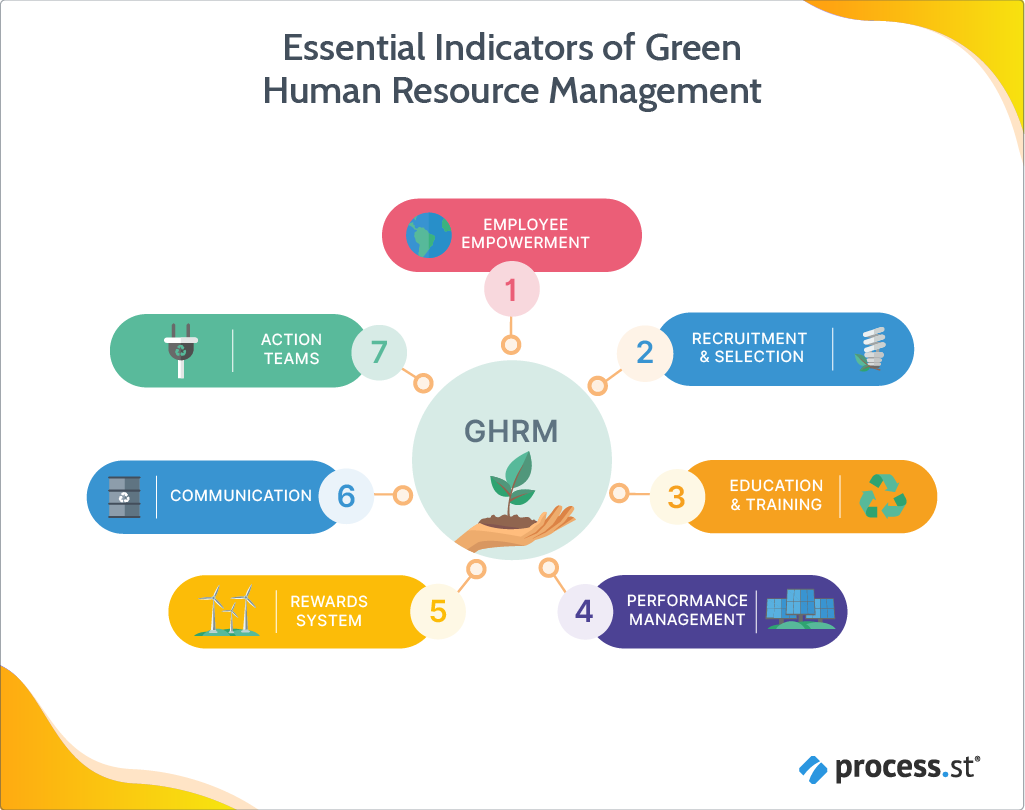
If you look at the diagram above, you’ll see that I’ve outlined the 7 key indicators of successful GHRM practices. This is by no means an exhaustive list, nor is it meant to imply other practices don’t fall under the GHRM umbrella. These 7 indicators, however, are the most common and generally accepted as features of Green HRM.
It’s important to note that not only do these indicators inform GHRM practices, but your company’s GHRM practices will also inform each of the indicators in a symbiotic relationship. In this section, I’ll provide a general overview of each one, while in the next, I’ll provide actionable steps you can take to improve your environmental management strategy.
- Recruitment and selection
The easiest, simplest, most cost-effective way to establish an environmentally aware workforce is to hire environmentally aware employees. Individuals who already have the knowledge, values, and behaviors in their personal lives are more likely to carry those attributes over to their work lives. - Education and training
As with any skill, it’s necessary to constantly ensure skills are up-to-date and current, particularly as innovations and discoveries occur. Plastic is a good example of this. Initially, it was a revolutionary material that offered manufacturers and consumers an inexpensive, safe, and sanitary alternative to traditional materials. Concerns about waste in the ‘80s were met with assurances that plastic was highly recyclable and therefore still a better alternative to natural materials. We now know that recycling plastic is expensive, finite, and leaves its own hefty carbon footprint. - Performance management
There’s no point in doing something if you aren’t going to track how well (or poorly) it’s being done. Not only will adding PEB goals to your performance management system let you know how effective your environmental management initiatives are, but it’ll also provide insight into where employee and/or managerial engagement is failing. - Reward systems
Major corporations such as Disney, Marriott, and Singapore Airlines all offer employees incentives for adopting PEBs. Offering monetary and non-monetary rewards for eco-friendly behavior provides an extra incentive to make more Green choices. - Communication
Communication is neither a one-way nor a two-way street; communication is a massive, diverging interchange constantly moving in all directions. You need data from experts on developing good strategies. You need suggestions and input from employees on development and implementation. You need feedback from clients and colleagues on what’s working and what needs improvement. - Action teams
Depending on your company, action teams can be voluntary, extra duties employees take on, or mandatory assignments with a dedicated focus. Either way, empowering a team to drive your eco-efforts is an effective way to gain momentum within your organization. - Employee empowerment
I used the word “empowering” with action teams deliberately. Employee empowerment is a dynamic, yet underutilized, tool. Empowering your employees to take on problems, decisions, and situations for themselves will 1. Take that thing off your plate and 2. Create a sense of ownership and investment in that individual.
AMO framework
The AMO framework was initially developed by economist Thomas Raymond Bailey in his book, Discretionary Effort and the Organization of Work. Bailey suggested that for an employee to “go above and beyond”, there were three requirements:
- Ability
- Motivation
- Opportunity
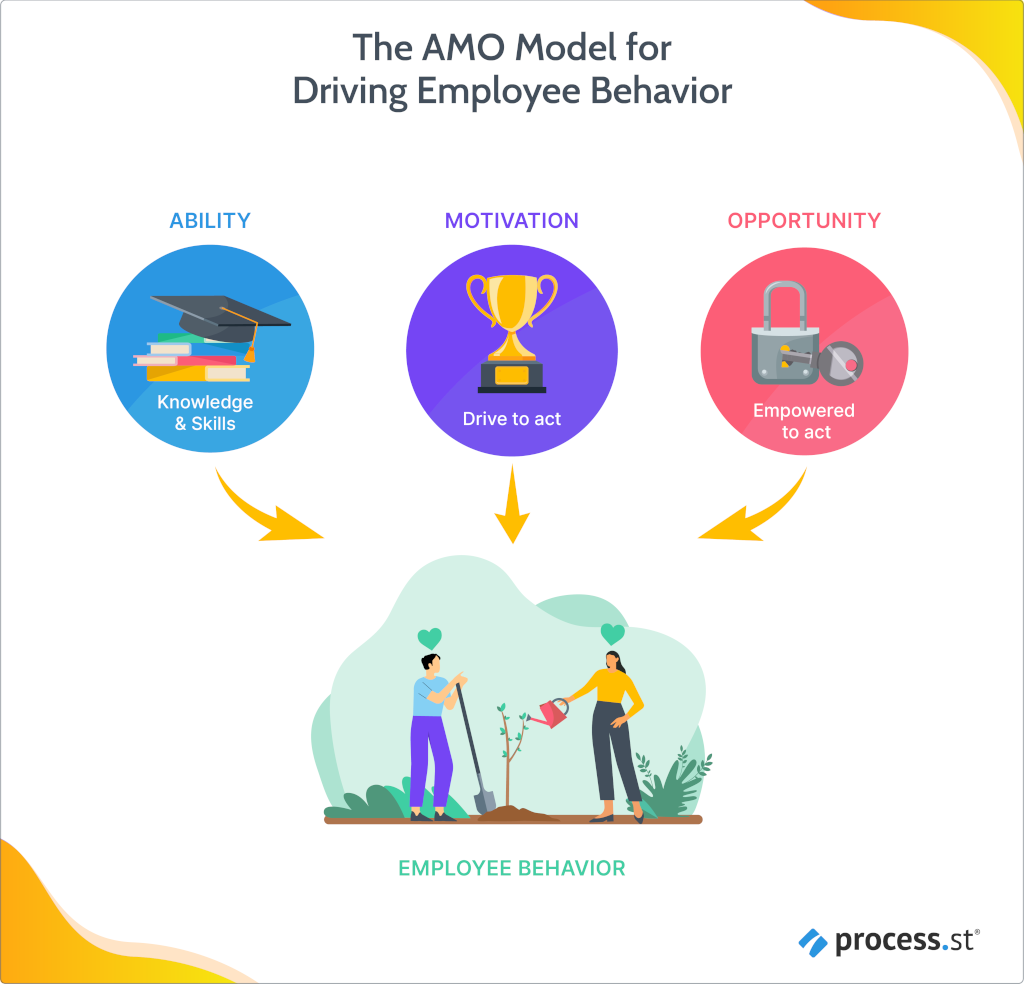
According to this model, when all three components are present, people perform at their best. So, for employees to reach their full potential, managers need to be aware of and develop strategies that offer enhancements to their abilities, motivations, and opportunities to participate.
Since its inception in 1993, the AMO framework has become one of the most dominant theories in HRM to explain the effects of HR practices on employee outcome. With that in mind, I’ve opted to categorize the 7 indicators of GHRM within the 3 elements of the AMO framework to provide a structure for successful GHRM implementation.
Click for citations
Marin-Garcia, J.A. and Juan Martinez Tomas (2016). Deconstructing AMO framework: a systematic review. Intangible Capital, [online] 12(4), p.1040. DOI: https://doi.org/10.3926/ic.838.
Walk the talk: Promoting Green values within your company
As I said earlier, the Green-ness of your business relies heavily on the support and participation of your employees. While not one of the key drivers of environmental management, employees are often reported as one of the main sources of pressure for organizations to address environmental issues.
Without the trinity of ability-motivation-opportunity, however, even the most eco-friendly employee won’t take on more than the bare minimum. Even if your teams are the most eager to kickoff new Green initiatives within your organization, it’s up to you to implement HRM practices that empower them to take on those roles.
There’s that word again. It’s almost like it’s a theme or something.
Click for citations
Berry, M.A. and Rondinelli, D.A. (1998). Proactive corporate environmental management: A new industrial revolution. Academy of Management Perspectives, [online] 12(2), pp.38–50. DOI: https://doi.org/10.5465/ame.1998.650515.
Ability: Green branding, not Green-washing
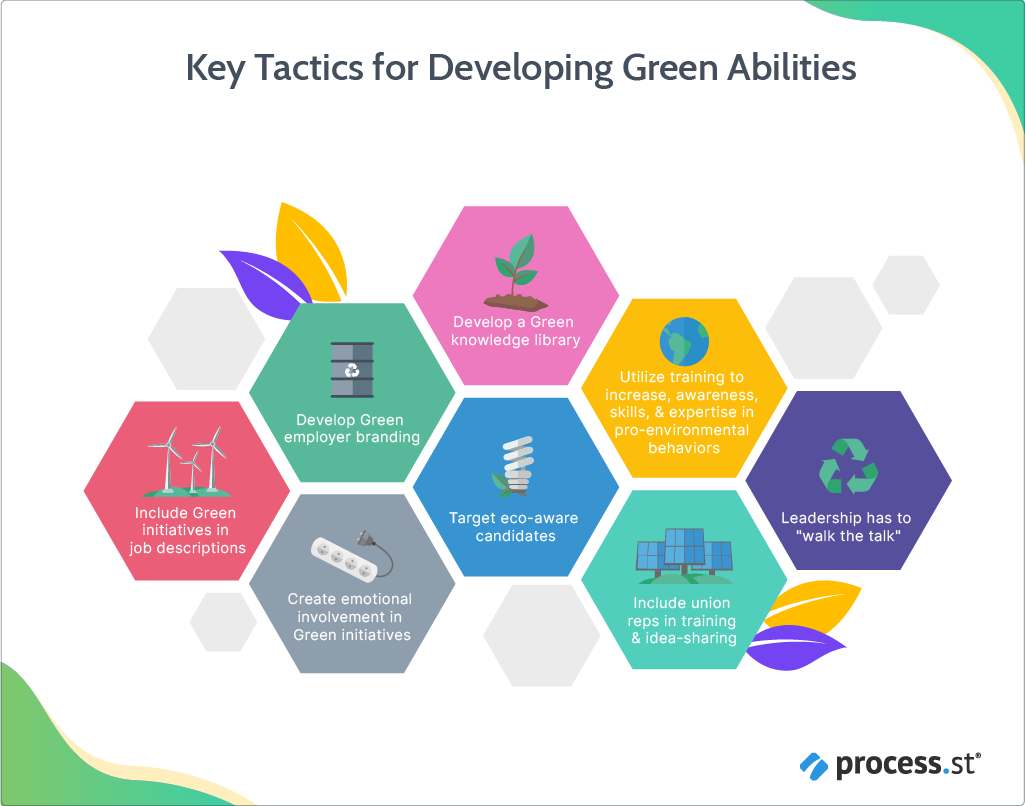
Branding yourself as a Green employer is a vital part of attracting that eco-aware talent your business definitely needs. It’s equally important to mean it.
The flip side to Green branding is Greenwashing. Greenwashing is everything you don’t want your marketing strategy to be: deceptive, dangerous, unethical, and out-of-sync with the majority of today’s consumers – and the majority of today’s jobseekers.
61% of Millennials are willing to pay more for sustainable products; 76% would take a lower salary to work for a socially responsible company.
Millennials are literally willing to put their money where their mouth is; they expect the companies they work for to do the same.
Click here for a preview of the BSR Greenwash Prevention Checklist
Based on guidelines set out by Business for Social Responsibility (BSR), this workflow can be used to assess how honestly and effectively you’re communicating your organization’s Green initatives.
Click here to add this workflow to your free Process Street account!
Recruitment and selection
![]()
“Attracting high-quality staff is a key HR challenge in the ‘war for talent’.” – Renwick, et al
Naturally, if you want to maintain a profile as a sustainable company, you need to recruit individuals with Green values who will not only support the initiatives you have in place but openly promote them as well. According to Amrutha and Geetha (2019), the acquisition and retention of top Green talent are one of the most important tools for an organization to achieve sustainability targets.
The other side of the coin is that, in the current market, Green companies are the workplace of choice among job seekers. More and more frequently, job hunters are focusing on companies making a societal and environmental impact. 42% of the workforce want to work for an organization that positively impacts the world and 36% say they’d work harder for a company the benefitted society.
“By creating a culture and environment which has values that are meaningful and aligned with those of staff, people are more motivated to work for you and will bend over backwards for things that they believe in.” – Simon Cohen, activist/entrepreneur/writer/speaker
According to Renwick et al (2013), not only are pro-environment behaviors important to attracting high-quality talent, but according to their review of GHRM literature, applicants are also prepared to make salary sacrifices to work for an environmentally responsible organization.
In their respective papers, both Turban et al (2017) and Jones et al (2014) asserted that highly qualified candidates – that is, job seekers with the most choice in terms of role – used an organization’s corporate social performance (CSP) as a determining factor when location, salary, and responsibilities offered little variance.
According to Jones et al, this is more about the perception a company’s CSP creates than the actual results of those actions. They theorize that the appeal of positive CSP relies on three influencers:
- The anticipated pride or prestige of working for a Green business;
- Perceived fit between the candidate’s values and the organization’s;
- CSP indicates the organization is more likely to treat employees well.
However, Deloitte’s Global 2021 Millennial and Gen Z Survey showed that for Millennials, environmental issues are their third greatest concern, while Gen Z put the environment as their primary issue. The same report revealed that 70% or more of both generations agreed that:
- Businesses were focused more on their own agendas than considering wider societal implications;
- And businesses have no ambitions beyond making money.
Taking those views into consideration, it’s obvious why Green business is so attractive to top talent. Your best bet for securing that talent is to set your company apart from your competition by highlighting your own initiatives.
- Target eco-aware candidates
This seems self-explanatory, but to attract eco-aware candidates, you need to seek them out. Utilize the channels they use – and ones that indicate your own eco-awareness. Use e-recruitment, digital interviews, and tracking software to eliminate waste, cut down on emissions, and, frankly, make your job easier by automating your recruitment process. - Include Green initiatives in job descriptions
When writing up all the advantages of joining your company, be sure to include the pro-environmental behaviors your company participates in. For one, it will trigger the influencers Jones et al identified: prestige, values, and treatment. It will also distinguish your company from the herd, particularly for the eco-aware candidates you really want to recruit. - Be transparent about your strategies
This will come up again when I discuss Green opportunities, but it’s never too early to inform potential candidates about what you’re currently doing – and what you plan to do – in terms of protecting the environment. Before they’re job seekers, candidates are customers, consumers, and clients. By the time they read your job posting, they will have already established an opinion on what your company stands for. Utilize Green branding to become a company that prospective candidates target.
Pro tip: It’s worth repeating – Green branding is not Greenwashing. Marketing yourself as an eco-friendly company only works if you are an eco-friendly company. If you don’t walk the talk, this strategy will backfire spectacularly.
Click for citations
Amrutha, V.N. and Geetha, S.N. (2019). A systematic review on green human resource management: Implications for social sustainability. Journal of Cleaner Production, [online] 247, p.119131. DOI: https://doi.org/10.1016/j.jclepro.2019.119131.
Jones, D.A., Willness, C.R. and Madey, S. (2014). Why Are Job Seekers Attracted by Corporate Social Performance? Experimental and Field Tests of Three Signal-Based Mechanisms. Academy of Management Journal, [online] 57(2), pp.383–404. DOI: https://doi.org/10.5465/amj.2011.0848.
Renwick, D.W.S., Redman, T. and Maguire, S. (2012). Green Human Resource Management: A Review and Research Agenda*. International Journal of Management Reviews, [online] 15(1), pp.1–14. DOI: http://dx.doi.org/10.1111/j.1468-2370.2011.00328.x
Turban, D.B. and Greening, D.W. (1997). Corporate Social Performance And Organizational Attractiveness To Prospective Employees. Academy of Management Journal, [online] 40(3), pp.658–672. DOI: https://doi.org/10.5465/257057.
Education and training
Once you have your highly talented employees, you need to train and educate them. Naturally, you’ll want to include information and instructions on your established PEB policies and systems in your initial onboarding process.
That’s a good start, but what we know about the environment and our impact on it is constantly evolving. Throughout the ‘80s and ‘90s, emphasis was heavily placed on the “recycle” part of “reduce, re-use, recycle”. Over time, it’s become apparent that recycling is not as sustainable as we once thought. More to the point, according to a report published by Science Advances in 2017, only about 9% of the 8.3 billion tons of produced plastic actually gets recycled. Lead author Roland Geyer estimates that – best cast scenario – only 20% of plastics are being recycled per year on a global scale.
“It’s really a complete myth when people say that we’re recycling our plastics. […] I hate to break it to everyone, but these places are routinely dumping massive amounts of [that] plastic and burning it on open fires.” – Jim Puckett, executive director, Basel Action Network
This is the type of development you need to be aware of, and to make your workforce aware of, which is where continuous education and training comes in. Additionally, by providing your employees with the abilities and expertise to practice pro-environmental behaviors, proper training will instill an emotional investment in these behaviors. The more invested in an initiative your employees are, the more likely they are to participate in it.
You also need a place to store all of this information that is both easily accessible and easily updated. Creating a digital knowledge base of company practices, environmental management developments, and relevant resources will empower employees to take ownership of their own PEBs, at work and at home.
Union representatives are actually a great asset when it comes to training and idea-sharing. Many PEBs overlap with workplace health and safety regulations, making unions some of the most experienced organizations when it comes to Green initiatives. Tapping into their knowledge will greatly reduce the amount of legwork you have to do, plus knock out your health and safety regs with the same stone.
ISO 14001 certification is a good example of this. ISO 14001 maps out a framework that organizations of any type can use to develop an environmental management program.
Click here for a preview of the ISO 14001 Environmental Management Self Audit workflow
Click here to add this workflow to your free Process Street account!
Click for citations
Geyer, R., Jambeck, J.R. and Law, K.L. (2017). Production, use, and fate of all plastics ever made. Science Advances, [online] 3(7), p. DOI: https://doi.org/10.1126/sciadv.1700782.
Motivation: Recommend, reward, recognize
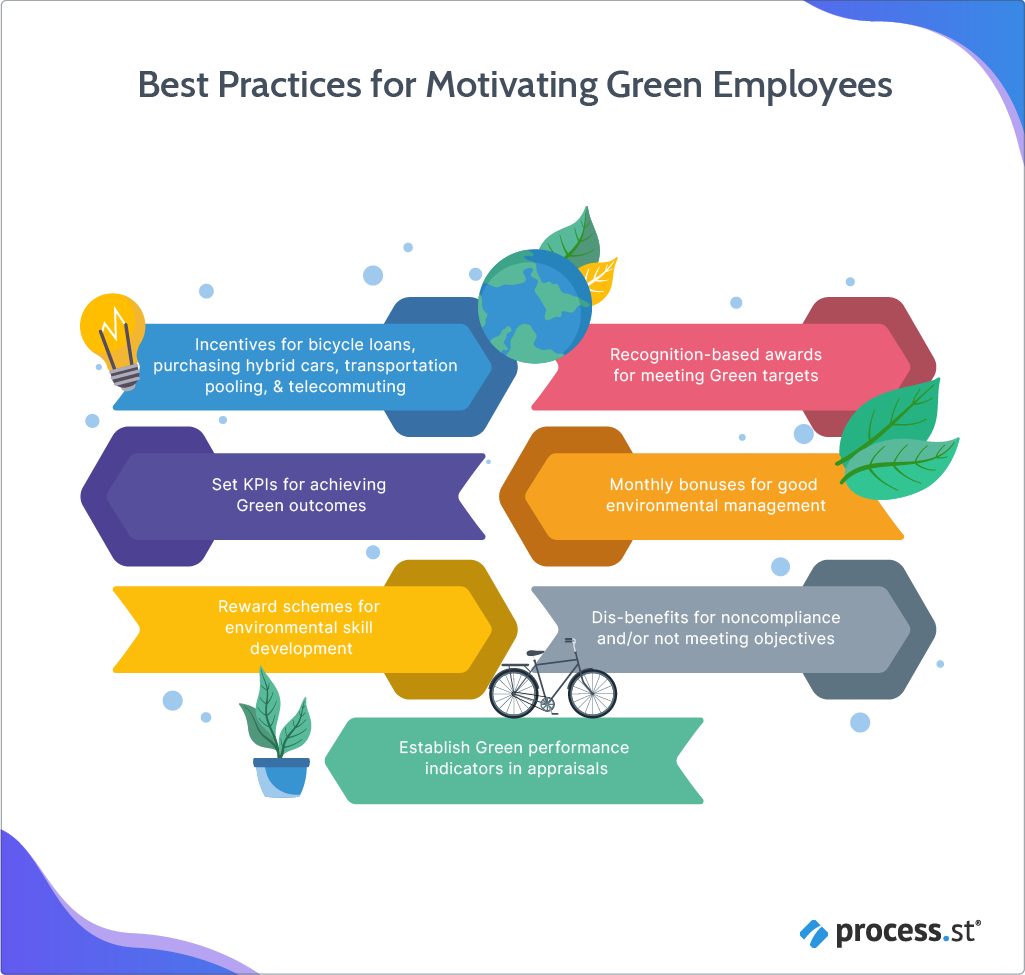
Engaging employees effectively in corporate responsibility efforts can result in a more dedicated, fulfilled workforce; one that’s likely to stick around in a time when employees overall are increasingly transient.” – Cone Communications
Look, I’m not going to patronize you by describing in detail why employee engagement is important for retention and well-being. You know that already. While employees typically think of HR as the people who process their paperwork (or the people who scold them for bad behavior), the truth is, HR is constantly there in the background working to keep the company culture, environment, and people happy, healthy, and working the way they should.
The good news is: if you’ve been actively recruiting eco-aware employees, it’s likely you won’t have to bend over backward to get them on board. If you look at the numbers, for most, the motivation is already there. According to Cone Communications’ Employee Engagement Study:
- 70% of employees feel more loyal to their employers when they’re able to make a positive social and/or environmental impact at work.
- 74% describe their work as more fulfilling when they can make a positive impact.
- 77% of employees believe it’s important for their employer to provide hands-on activities that promote and support pro-environmental behaviors.
- 78% want to actively improve their company’s responsible business practices.
Even if your employees aren’t the most eco-minded of folk, professional growth (87% of employees) and financial incentives (85%) are among the top three motivators for engaging in PEBs. Either way, positive reinforcement is an effective way to create patterns of behavior. Sure, Thomas in sales is already a driving force behind your Green initiatives, but that doesn’t mean he wouldn’t appreciate a public shout-out or even a gift card to an eco-friendly store. Even the most selfless person needs a little recognition after all.
Plus, think about the goodwill. My employer wants to pay me for something I’d do anyway? Awesome! I’m down for that. Who wouldn’t be? And you know what? The next time my manager pops by and asks if I’ll take on an extra project, I’m much more likely to:
- Say yes;
- Be happy about it.
Why? Because I feel valued and appreciated. Treating people well goes a long way.
Performance management
You need to know if your Green practices are actually effective, being adhered to, and up-to-date. The most efficient way to gauge those things is to conduct performance appraisals. You should hold appraisals for teams, departments, and the company as a whole, but it’s also important to understand the level of commitment each individual has as well.
First and foremost, decide what your Green KPIs are. Managers need to be fully aware of the goals and outcomes they are working towards to effectively motivate their teams to achieve them.
Your performance appraisals can be specific to your organization’s Green practices, or they can be included in your regular performance reviews. The latter is preferable when it comes to evaluating individual performance as it positions PEBs as part and parcel of an employee’s duties and responsibilities.
Once the appraisals are completed, it’s vital to recognize those who’ve made strides towards reaching their objectives. I’ll discuss reward systems in a bit, but first I want to mention dis-benefits.
“Dis-benefits” is really just a clever word for disciplinary action. If an appraisal reveals that an employee or manager is either not meeting company objectives, or is outright non-compliant, it needs to be addressed with some sort of corrective action. This can follow your company’s established procedure, or include consequences specifically related to PEB practices.
Pro tip: The structure and execution of dis-benefits need to match your company culture and values, but also must adhere to local employment laws and regulations.
Reward systems
People like rewards, even if they’re doing something they would have done anyway. We all like a little bit of acknowledgment when we do a good thing or perform well. Rewards will, of course, play a considerable role in motivating your employees to take on PEBs. It’s also true that the easier you make it for an individual to act, the more likely they are to do it.
In line with the performance appraisals, you can recognize employees and managers who meet Green targets, either with an actual award, a monetary bonus, or an additional perk. Some companies have issued “carbon credit cards” or “Green benefit cards” that allow employees to purchase eco-friendly products and rewards for themselves. Others hold awards dinners and special events to recognize employee achievements.
Disney, for example, runs a commuter assistance program that offers incentives for eco-friendly behaviors. This could be a simple act like providing bicycles on loan, incentives for transportation pooling and telecommuting, or even tax credit for purchasing hybrid or electric cars.
Again, how you develop your reward system will depend on your company’s capability, structure, and local regulations. Even if your recognition only consists of an announcement in a company-wide newsletter, providing that acknowledgment is vital in reaffirming your employees’ behavior.
Opportunity: Sustaining a culture that thrives
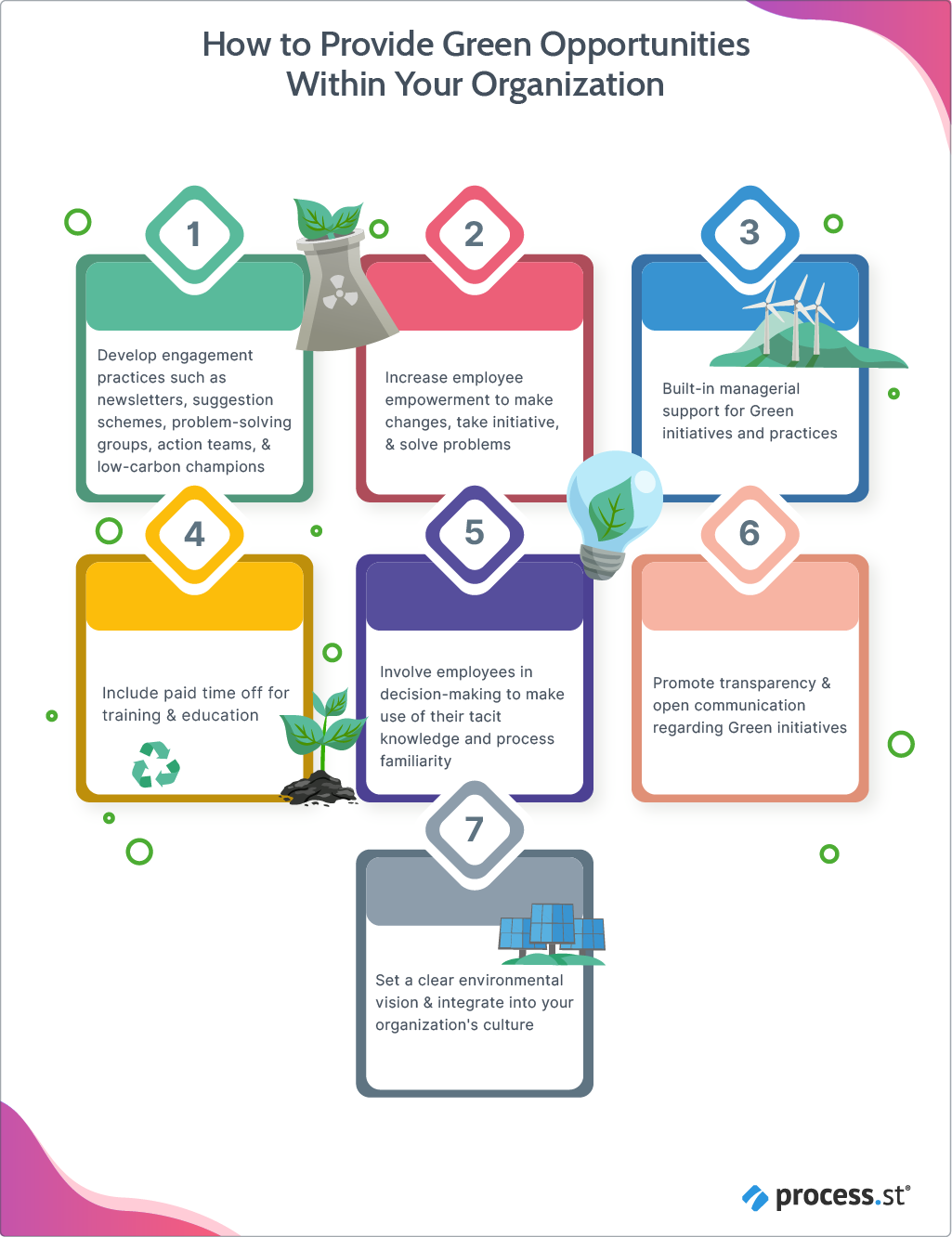
It’s a well-established fact that engaged employees are productive employees. Providing opportunities for your employees to participate in pro-environmental behaviors and the company’s environmental management, in general, is essential for establishing and maintaining that engagement.
For your Green initiatives to be successful – and to benefit not only the environment but your organization as a whole and your employees as individuals – you need to create an environment where they can utilize their abilities and motivation to do something meaningful.
Building a culture of PEBs and eco-awareness is not just a matter of rhetoric and company-sponsored volunteer days. Literally creating a Green environment for your employees to work in will improve both their physical and psychological health. I’ve already mentioned how involving union representatives can help optimize your healthy and safety regulations with sustainable solutions, but how do you make your employees feel better at work?
The Building the Business Case: Health, Wellbeing, and Productivity in Green Offices report from the World Green Building Council (WorldGBC) showed that not only does office design impact employee health and wellbeing, but Green office design improves both employee well-being and the company’s bottom line.
“While our earlier work presented the overwhelming evidence between office design and improved health and wellbeing of workers, this report breaks new ground by demonstrating tangible action businesses are taking to improve their workspaces. The results are clear – putting both health and wellbeing, and the environment, at the heart of buildings, is a no brainer for businesses’ employees and the bottom line.” – Terri Wills, CEO WorldGBC
The report identified 8 factors of Green offices that impact the bottom line:
- Indoor air quality and ventilation: Proper ventilation can double cognitive ability.
- Thermal comfort: Performance falls in offices that are too hot (6%) or too cold (4%).
- Lighting: Employees in offices with natural light slept 46 minutes longer at night than those without.
- Acoustics: Noise distractions can cause a 66% loss in performance and concentration.
- Interior layout and design: A flexible approach helps staff feel more in control of their workload and thus increases loyalty.
- View: Having a view of nature at work can improve productivity by 7-12%.
- Aesthetics: Visual appeal is a major factor in workplace satisfaction.
- Location and amenities: A Dutch cycle to work scheme saved approximately $32 million in reduced absenteeism.
Something as simple as introducing more greenery to your office space (which will also improve air quality slightly) can have a dramatic impact on employee productivity, absenteeism, turnover, and medical costs. A reduction in absenteeism and turnover will ease the workload on your remaining employees, which in turn reduces stress, anxiety, burn-out, and hostility among coworkers. These all impact your employees’ emotional and psychological wellbeing, but they can also have a very serious influence on physical health as well.
Communication
I mentioned communication briefly in the recruitment section, but it is equally important at this stage. Keep your employees informed about your initiatives and their progress. You may want to create a Green newsletter that regularly updates employees on company practices, new resources, and recent innovations. This promotes transparency and open communication, but it also makes PEBs part of your employees’ daily routine.
To communicate your initiatives, you also need to have a clear vision that’s fully integrated into your company culture. Use your communication channels to inform employees of community events they can participate in (and offer PTO or other rewards for doing so). Organize company-wide “clean-ups” or eco-friendly campaigns.
You want to ensure that your communications are multi-directional, though. Develop suggestion schemes and problem-solving groups to provide your employees with a sense of ownership. Involve them in how decisions are made regarding Green practices, and utilize their tacit knowledge to improve the practices you already have.
“An organizational culture that supports [environmental management] is one that encourages employees to make suggestions for and the freedom to engage in, activities that improve the environment.” – Renwick, et al
Action teams
One of the best ways to involve employees is to set up action teams, or “Green teams”. Depending on your company’s size and structure, this may be a purely voluntary group made up of particularly interested individuals within your organization. For a larger company, you may want to consider creating a dedicated team that’s responsible for your organization’s CSP on both internal and external fronts.
The benefit of an action team is quite simple: ground-level employees who use the equipment and processes daily know how it works best. Those employees will be able to identify updates and changes that no one else will. They’ll also know which things simply won’t work with the current resources.
With action teams, employees become part of the development process. They aren’t having rules and regulations dictated to them; they have a voice in how the organization evolves, which also means they now commit to that organization’s success.
“It is an established fact that the employees having an opportunity to make a direct environmental impact through their jobs report higher levels of satisfaction at work compared to those who do not.” – Amrutha, et al
Employee empowerment
Yet again, we have arrived at employee empowerment. Whether you are just hearing about Green HRM or have been incorporating it into your established HR practices, you need to enable your employees to act on their own initiative.
Your employees need to be invested in your organization’s values, committed to adopting these behaviors, and trusted to problem-solve and make changes – especially in the areas they are most knowledgeable in. The person performing a role usually knows how to do it best, so step back and let them drive the process.
Managerial support is an important facet of employee empowerment. Employees need to feel assured that their managers have their back. They need to know that their contributions are appreciated and their knowledge is valued.
The primary reason for employee dissatisfaction, disengagement, and turnover is poor management. If your managers aren’t invested in your employees, your employees won’t be invested in their jobs. If that’s the case, it’s only a matter of time before they take their abilities and motivations to a company that will offer them the opportunities they need.
“You have to mean it, because people can smell if you’re full of it. You need to be able to communicate to your team that you care about them, and that they’re valuable to you, both as an employee and as a human being.” – Jay Hanlon, VP of People and Operations, Process Street
Green HRM: Final thoughts
While the terminology for Green HRM is new, the concepts behind it are the same concepts that have been driving people management for decades – just Greener.
Productive employees need to be engaged, have high job satisfaction, and balanced work and personal lives. In other words, if you want productive employees, you need to have happy employees.
Climate change and environmental concerns are at the forefront of most people’s minds, so logically have become important issues when it comes to choosing an employer. To keep up, companies must either adapt or die – and their workforces are going to be the determining factor there.
GHRM is an investment in your employees’ values. It shows your commitment to them as employees and as people by showing your commitment to the issues that matter most to them. Even if your Green initiatives don’t directly provide monetary benefits, they will definitely have a return on your investment.
“Therefore, Green HRM may also improve economic performance by contributing to HRM-related competitive advantages such as superior human capital, employees’ involvement, and skills repertoire.” – Ana Labella-Fernández and Javier Martínez-del-Río, “Green Human Resource Management”
Have you implemented any Green initiatives at your workplace? Let us know in the comments below!







 Workflows
Workflows Projects
Projects Data Sets
Data Sets Forms
Forms Pages
Pages Automations
Automations Analytics
Analytics Apps
Apps Integrations
Integrations
 Property management
Property management
 Human resources
Human resources
 Customer management
Customer management
 Information technology
Information technology



Leks Drakos
Leks Drakos, Ph.D. is a rogue academic with a PhD from the University of Kent (Paris and Canterbury). Research interests include HR, DEIA, contemporary culture, post-apocalyptica, and monster studies. Twitter: @leksikality [he/him]